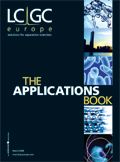GC–MS Determination of Phthalate Concentration in Plastic Toys
The Application Notebook
Phthalates are added to plastics to increase flexibility. Recently, concerns have been raised over the effect of phthalate exposure from plastic materials on human health.
William Goodman, PerkinElmer Inc., Waltham, Massachusetts, USA.
Introduction
Phthalates are added to plastics to increase flexibility. Recently, concerns have been raised over the effect of phthalate exposure from plastic materials on human health. This health concern has resulted in regulations regarding the type and levels of phthalates allowed in toys. Gas chromatography–mass spectrometry (GC–MS) is an excellent instrumental platform for the identification and quantification of phthalates in plastic-toy components. This paper will demonstrate a GC–MS calibration for common phthalates and the analysis of plastic-toy components for phthalate content.

Figure 1
Experimental
The PerkinElmer Clarus 600 GC–MS system provided the instrumental platform for this analysis. The GC was fitted with a programmable split/splitless injector; the injector-port temperature was maintained at 280 °C. The injector-port liner was packed with glass wool to improve vaporization and provide a surface for the collection of any dissolved plastic. A PerkinElmer Elite-5ms (30 m × 0.25 mm × 0.25 μm) GC column was temperature programmed from 100 °C to 260 °C at 8 °C/min, then to 320 °C at 35 °C/min. The carrier gas, helium, was set to 1 mL/min with 25 mL/min split at the injector port. Phthalate calibration standards were prepared in methylene chloride across a range of 1 and 160 μg/mL; the calibration standards used contain 16 phthalates.
An unused toy was broken into small pieces; 1 g samples were taken from each of the 9 different types of plastics used in the toy. The samples were extracted through 15 minutes of sonication in 10 mL of methylene chloride, in a sealed vial. Following extraction, 1 mL of the sample extract was transferred into an autosampler vial for analysis; a 1 μL injection was made.
Discussion
The instrument calibration across the range of 1 to 160 μg/mL for each phthalate was linear with R2 greater than 0.999 for all compounds. Applying the calibration range to a 1 g sample extracted in 10 mL of solvent relates a % weight calibration range of 0.001 to 0.16% weight phthalate in the sample.
The analysis of the toy samples resulted in detection of phthalates in each of the different plastic materials; however, the phthalate level of all analyses was well below the regulatory limits. A sample analysis is pictured in Figure 1. In the chromatogram, three peaks are evident: butylated hydroxytoluene, diisobutyl phthalate and din-butyl phthalate. Butylated hydroxytoluene is an antioxidant commonly added to polymers. The total % weight of phthalates in this component was 0.007%.
Conclusion
European and North American countries have set limits on the acceptable levels of phthalates in toys. As a result, a reliable technique to determine the phthalate level in toys is necessary. The GC–MS technique presented here will allow for the determination of the phthalate content in plastic-toy components.

PerkinElmer Inc.
940 Winter Street, Waltham, Massachusetts 02451 USA
tel. +1 800 762 4000 or +1 203 925 4602
fax +1 203 944 4904
Website: www.perkinelmer.com

Detecting Hyper-Fast Chromatographic Peaks Using Ion Mobility Spectrometry
May 6th 2025Ion mobility spectrometers can detect trace compounds quickly, though they can face various issues with detecting certain peaks. University of Hannover scientists created a new system for resolving hyper-fast gas chromatography (GC) peaks.
Automated Sample Preparation (ISO 20122) for MOSH/MOAH in Seasoning Oils
May 6th 2025This work presents an Automated Sample Preparation procedure for MOSH/MOAH analysis of Seasoning Oils. We compare results from a manual epoxidation procedure compliant with DIN 16995 with results based on fully automated sample preparation (epoxidation and saponification) compliant with ISO 20122. In both cases, online clean-up via activated aluminum oxide (AlOx) are used to remove interfering n-alkanes from the MOSH fraction during the HPLC run. Automated data evaluation using a dedicated software (GERSTEL ChroMOH) is presented.
Altering Capillary Gas Chromatography Systems Using Silicon Pneumatic Microvalves
May 5th 2025Many multi-column gas chromatography systems use two-position multi-port switching valves, which can suffer from delays in valve switching. Shimadzu researchers aimed to create a new sampling and switching module for these systems.

.png&w=3840&q=75)

.png&w=3840&q=75)



.png&w=3840&q=75)



.png&w=3840&q=75)









